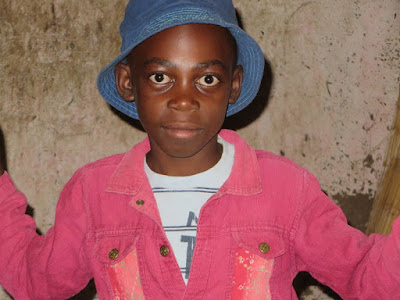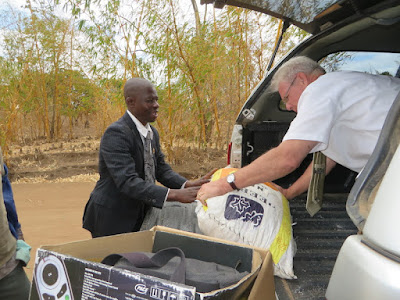https://www.forceforgood.org/ffg/en/projects/school_of_agricultureforfamilyindependencesafi.html
For the first year, the Kanjalas will live and learn agricultural techiniques with 30-40 other selected families and then, the second year, they will return to their village and implement those techniques and teach those around them. SAFI will continue to monitor their progress.
The Kanjalas moved to Blantyre from their village a few years ago because he wanted to be closer to the church. It wasn't long after joining that he was called to be the president of the Blantyre 2nd branch. He has been a dedicated shepherd to his flock, but it has been a challenge to support his family while in the city. Back in the village, he had several parcels of land. Periodically he would go back and plant or let out the land to others but he knew that he needed to do more. When he interviewed with Elder and Sister Bingham, who were at that time the self-reliance missionaries, they told him about the SAFI program. That was months ago and there were several steps along the way. Even after acceptance, there many preparations. President Kanjala asked us if we could take him to his village so he could get five bags of maize to take with him to the north. On Monday, we got an early start, picking up President Kanjala, Jessie, their son Yankho (means "answer" in Chichewa), and of course, Victor.
We drove to the village of Kalilima in the district of Mulanje. It was a cloudy day so we couldn't get a very good view of Mulange, a massive rock mountain that dominates the landscape.
Kalilima is not far off the main road. There is a trading center on the main road and then, as is typical, there are several dirt roads leading to various villages both near and far.
Our first stop was to visit President Kanjala's "mother". We never get the relationships straight but we think she is a sister to his deceased mother. Of course, Victor was the star of the show. In addition to Jessie (in the gray jacket), there was his sister and another relative.
Proud grandmother and mother.
He is very tender toward her because he said that "she is all that I have left" meaning of that generation.
Then President Kanjala took us on a short walk to show us some of his fields.
A relative was working one of the fields. Her little toddler was sitting in one of the furrows. He began to howl when he saw us (maybe we were the first azungu he had seen?) so we did not dare take a photo.
Yankho joined us as we walked around. Even though September is supposed to be a very warm month, it was a cool day and you can see it was windy.
Yankho does not speak much English but we have really bonded in Primary.
We were introduced to his brother-in-law who was working hard in a small grove of blue gum (eucalytus) trees. He was making bawo boards to sell at the market in Blantyre.
Bawo (or "bao") is the Malawian version of Mancala. Groups of boys and men play it all day long but it is so fast moving that when I observe, I can't tell how it is played!
Another relative was working alongside him.
We walked back to the house passing other buildings in the compound.
Aren't these cool chairs on the front porch? I had never seen this style before,
and they were comfortable.
Before we left this home, they insisted on our having a drink of thobwa, a drink made of maize flour and water. It's a very popular Malawian tradition and we have seen people making it before. It is common to make a large batch of it so there will be enough for a few days. With no refrigeration, they simply reboil it each day. We would call it gruel.
In this case, they said they had also added sorghum.
The drink was actually room temperature and they recommended that we put sugar (in the brown bowl) in it. I never pass up a chance to add sugar!
It was actually quite tasty. They insisted that for those working in the fields, if they bring a 2 liter bottle of thobwa with them, they will have the energy they need to work hard the entire day!
As we were preparing to leave the first house, there were tender good byes
and I got to hold little Victor.
Before we left, President Kanjala pointed out a plant to me and said that the people get very strong fibers from the cut leaves, using them for ropes and for mats. It looked so much like the small agave plants that I put in pots on San Juan Island (because it was one plant that the deer wouldn't eat). I googled it later and sure enough, it is an agave and when used for mats and such, is what we know as sisal.
When we got to the next group of homes, it looked very familiar. We had come in April for the funeral and burial of President Kanjala's father and the mourners had sat outside among the bamboo tree surrounding the house. We met other members of the family - aunts, cousins, nieces, nephews.
First President Kanjala took us to where he intended to build his own home when he returns. It is on the very spot where stood the house where he was born. Most homes of that age are no longer standing when originally made of mud bricks. It was on the other side of the road from the other houses and President Kanjala told us that his parents moved back across the street when he was a child because they were sure that witchcraft had jinxed the house. He is now determined to show people that witchcraft does not exist and so will build on the very same spot.
Again, we walked along, President Kanjala pointed out which parcels were his, telling us which had good soil, which ones had poor drainage, which were his favorite. He owns eight in total, and with proper agricultural techniques, it is more than enough to feed his family, help his extended family, and have enough money to take a bus to Blantyre for church each Sunday. Not expecting to be walking in fields, I was not very well prepared and was wearing sandals. He directed me to avoid the black stickery dropped pods, which would inflame my skin if touched.

Some people were already preparing their fields, in anticipation of the wet season coming in November.
There was one thing that made me stop dead in my tracks.
A mamba!
His head was down a hole as he was probably looking for mice.
Fine by me - I was out of there fast! (Although President Kanjala called it a green mamba, it had the habitat and appearance of a black mamba. I wasn't staying around to check it out!)
We walked along more fields, defined by trees and gullies.
The ubiquitous termite mound.
We came to another cluster of homes. President Kanjala knows all of the neighbors, calling them by name and chatting with them.
Just like the children, they burst into fits of laughter when George showed them the photos on our camera.
Chickens, goats, a pig,
and ducks.
We continued walking until we came upon an open spot underneath some trees.
This is where the chief sits in judgement whenever there is a dispute or if a village member has done something wrong.
I lightheartedly asked if the chief sits in a "chief's chair" since we see them in the craft market all the time. It is frequently intricately carved and folds up like a stool so it is easily portable, similar to this.
We actually did then walk to the chief's house. His surname was Kalilima because he "owns the village", said President Kanjala. He actually does own the land and the villagers have a right to lease the land. His actual title is group village headman and he was very gracious with a kindly face. He was very interested in what President Kanjala was doing and encouraged him to return and help the rest of the village when his program was complete.
It was now late morning and time to take care of the reason for our coming. We passed the brick kiln
until we came back to the home of his mother's sister
where the mother dog accommodated her wiggly pups.
At first, George and President Kanjala carried the 50 kg bags of maize to the car.
Then, President Kanjala's aunt insisted on showing them how it was done.
President Kanjala got the picture!
We are ready to go. Once more, a round of good-byes..

and we drive off, taking our last views of village life once again.




















































No comments:
Post a Comment